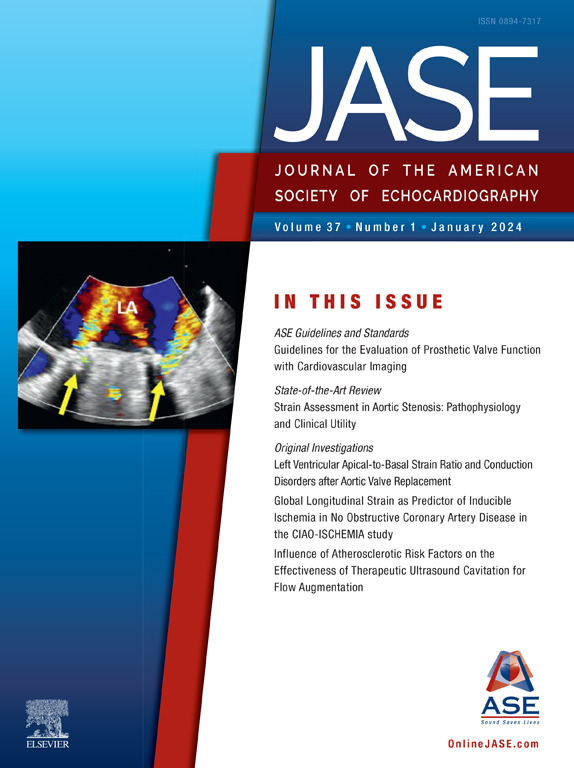The Right Ventricle and Exercise Capacity in Adults with Repaired Tetralogy of Fallot: Passive Bystander or Active Participant?
IF 5.4
2区 医学
Q1 CARDIAC & CARDIOVASCULAR SYSTEMS
Journal of the American Society of Echocardiography
Pub Date : 2025-03-01
DOI:10.1016/j.echo.2024.12.008
引用次数: 0
Abstract
Exercise intolerance is a hallmark symptom in adults with tetralogy of Fallot (TOF). This may be attributed to impairments in right ventricular (RV) function, augmentation in RV load, and their effect on left ventricular (LV) hemodynamics. To elucidate these mechanisms, we examined oxygen uptake (VO2) and cardiac hemodynamics in TOF and healthy controls at rest and during exercise. At peak exercise, VO2 was lower in TOF. This was partially attributed to lower heart rate in conjunction with a blunted exercise-induced change in LV stroke volume from rest to compensate for the chronotropic incompetence. Additionally, at peak exercise, pulmonary-RV was higher in TOF. Additionally, at peak exercise, in TOF, pulmonary-RV coupling negatively correlated with VO2 , changes in LV end-diastolic volume, and changes in LV SV from rest. These findings reveal the reliance of LV hemodynamics on the interplay between RV systolic load and function during exercise in TOF.
成人法洛四联症修复后的右心室和运动能力:被动旁观者还是主动参与者?
运动不耐受是成人修复法洛四联症(TOF)的一个标志性症状。这可能是由于疾病相关的右心室收缩功能损害,右心室负荷增加,以及它们对左心室血流动力学改变的综合影响。为了进一步阐明这些机制,我们通过间接量热法和超声心动图检测了34名TOF(48±14岁)和29名健康对照(41±15岁)在休息和运动时的摄氧量(VO2)和心脏血流动力学。在运动高峰时,TOF组的VO2 (VO2峰值)比对照组低15% (P < 0.001)。这部分归因于15%的心率降低(P < 0.001),以及运动引起的左室卒中容积(SV)的钝化变化(与对照组相比,TOF降低58%,P = 0.015),以补偿变时能力不足。肺动脉-右心室(P-RV)耦合是衡量右心室收缩负荷与右心室收缩功能指标的指标,与对照组相比,TOF患者在运动高峰时的肺动脉-右心室耦合比对照组高75% (P < 0.001)。此外,在TOF中,运动峰值时的P- rv耦合与VO2峰值(R = -0.65, P < 0.001)、左室舒张末期容积变化(R = -0.50, P < 0.001)和休息时的左室SV变化(R = -0.56, P < 0.001)呈负相关。这些发现揭示了TOF患者运动时左室血流动力学依赖于右室收缩负荷和功能之间的相互作用,并进一步阐明了导致该患者组有氧能力明显受损的潜在心血管机制。
本文章由计算机程序翻译,如有差异,请以英文原文为准。
求助全文
约1分钟内获得全文
求助全文
来源期刊
CiteScore
9.50
自引率
12.30%
发文量
257
审稿时长
66 days
期刊介绍:
The Journal of the American Society of Echocardiography(JASE) brings physicians and sonographers peer-reviewed original investigations and state-of-the-art review articles that cover conventional clinical applications of cardiovascular ultrasound, as well as newer techniques with emerging clinical applications. These include three-dimensional echocardiography, strain and strain rate methods for evaluating cardiac mechanics and interventional applications.

 求助内容:
求助内容: 应助结果提醒方式:
应助结果提醒方式:


